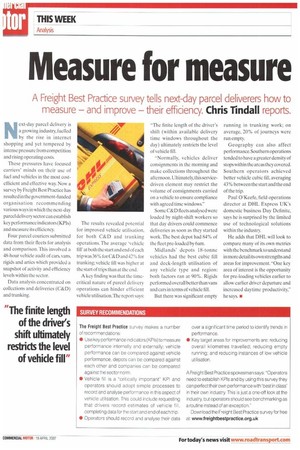Measure for measure
Page 26

If you've noticed an error in this article please click here to report it so we can fix it.
A Freight Best Practice survey tells next-day parcel deliverers how to measure — and improve — their efficiency. Chris Tindall reports.
Next-day parcel delivery is a growing industry, fuelled by the rise in internet shopping and yet tempered by intense pressure from competition and rising operating costs.
These pressures have focused carriers' minds on their use of fuel and vehicles in the most costefficient and effective way. Now a survey by Freight Best Practice has resulted in the governmen t-funded organisation recommending various ways in which the next-day parcel delivery sector can establish key performance indicators (KP1s) and measure its efficiency.
Four parcel couriers submitted data from their fleets for analysis and comparison. This involved a 48-hour vehicle audit of cars, vans, rigids and artics which provided a snapshot of activity and efficiency levels within the sector.
Data analysis concentrated on collections and deliveries (C&D) and trunking. The results revealed potential for improved vehicle utilisation, for both C&D and trunking operations. The average 'vehicle fill' at both the start and end of each trip was 36% for C&D and 42% for trunking; vehicle fill was higher at the start of trips than at the end.
A key finding was that the timecritical nature of parcel delivery operations can hinder efficient vehicle utilisation.The report says: -The finite length of the driver's shift (within available delivery time windows throughout the day) ultimately restricts the level of vehicle fill.
"Normally, vehicles deliver consignments in the morning and make collections throughout the afternoon.Ultimately,this servicedriven element may restrict the volume of consignments carried on a vehicle to ensure compliance with agreed time windows."
Some C&D fleets analysed were loaded by night-shift workers so that day drivers could commence deliveries as soon as they started work. The best depot had 84% of the fleet pre-loaded by 6am.
Midlands' depots 18-tonne vehicles had the best cubic fill and deck-length utilisation of any vehicle type and region: both factors ran at 90%. Rigids performed overall better than vans and cars in terms of vehicle fill.
But there was significant empty running in trunking work; on average, 20% of journeys were run empty.
Geography can also affect performance. Southern operations tended to have a greater density of stops within the areas they covered. Southern operators achieved better vehicle cubic fill. averaging 43% between the start and the end of the trip.
Paul O'Keefe, field operations director at DHL Express UK's domestic business Day Definite, says he is surprised by the limited use of technological solutions within the industry.
He adds that DHL will look to compare many of its own metrics with the benchmark to understand in more detail its own strengths and areas for improvement. -One key area of interest is the opportunity for pre-loading vehicles earlier to allow earlier driver departure and increased daytime productivity," he says. *
























































































































































































































